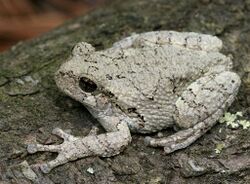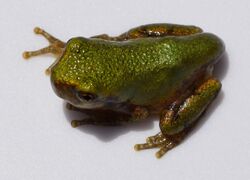Biology:Cope's gray tree frog
| Cope's gray tree frog | |
|---|---|

| |
| File:Hyla chrysoscelis call.ogg | |
| Scientific classification | |
| Domain: | Eukaryota |
| Kingdom: | Animalia |
| Phylum: | Chordata |
| Class: | Amphibia |
| Order: | Anura |
| Family: | Hylidae |
| Genus: | Dryophytes |
| Species: | D. chrysoscelis
|
| Binomial name | |
| Dryophytes chrysoscelis (Cope, 1880)
| |
| Synonyms | |
| |
Cope's gray tree frog[2] (Dryophytes chrysoscelis), also called the southern gray tree frog is a species of tree frog found in the United States. It is almost indistinguishable from the gray tree frog (Dryophytes versicolor), and shares much of its geographic range. Both species are variable in color, mottled gray to gray-green, resembling the bark of trees. These are tree frogs of woodland habitats, though they will sometimes travel into more open areas to reach a breeding pond. The only readily noticeable difference between the two species is the call — Cope's has a faster-paced and slightly higher-pitched call than D. versicolor. In addition, D. chrysoscelis is reported to be slightly smaller, more arboreal, and more tolerant of dry conditions than D. versicolor.[3]
Taxonomy
Edward Drinker Cope described the species in 1880. The specific name, chrysoscelis, is from Greek chrysos, gold, and scelis, leg.[4]
Microscopic inspection of the chromosomes of D. chrysoscelis and D. versicolor reveals differences in chromosome number. D. chrysoscelis is diploid, having two complete sets of chromosomes, the usual condition in vertebrates. D. versicolor is tetraploid, having double the usual number of chromosomes. Generally, D. versicolor is believed to have evolved from D. chrysoscelis in the last major ice age, when areas of extremely low temperatures divided populations. Despite currently sharing habitat, the two species generally do not interbreed.
Description
Both D. chrysoscelis and D. versicolor have black-marked bright orange to yellow patches on their hind legs, which distinguishes them from other tree frogs, such as D. avivoca.[3] The bright-yellow pattern is normally hidden, but exposed when the frog leaps. This "flash pattern" likely serves to startle a predator as the frog makes its escape.[5] Similar hidden bright patterns are common in various Lepidoptera, for instance moths of the genus Catocala.[6] Both species of gray tree frogs are slightly sexually dimorphic. Males have black or gray throats in the breeding season, while the throats of the females are lighter.[7]
Skin secretions from this species may be irritating or toxic to mouth, eyes, other mucus membranes.[8]
Distribution and habitat
The range of D. chrysoscelis is more southerly; it is apparently the species found in the lower elevation Piedmont and Coastal Plain of Virginia and the Carolinas. In those areas, D. versicolor may be present only in the Appalachians.[3] The bird-voiced tree frog, D. avivoca, is similar to D. chrysoscelis and D. versicolor, but is smaller (25–50 mm in length vs 32–62 mm for the gray tree frog).
Behavior
File:Hyla chrysoscelis call video.webm In the Southeastern United States, Cope's gray tree frog breeds and calls from May to August. Isolated males start calling from woodland areas during warm weather a week or more before migrating to temporary ponds to breed. There they form aggregations (choruses) and call together. Chorusing is most frequent at night, but individuals often call during daytime in response to thunder or other loud noises. Eggs are laid in batches of 10 to 40 on the surfaces of shallow ponds and other small bodies of water. These temporary bodies of water usually lack fish, and females preferentially lay their eggs in water bodies that lack fish or other predatory vertebrates and have lower desiccation risk.[9][10][11] Eggs hatch in about five days and metamorphosis takes place at about 45–65 days.[3][7][12]
Dryophytes chrysoscelis is capable of surviving temperatures as low as –8 °C.[13]
References
- ↑ IUCN SSC Amphibian Specialist Group (2014). "Hyla chrysoscelis". IUCN Red List of Threatened Species 2014. https://www.iucnredlist.org/details/55448/0. Retrieved 2015-01-17.
- ↑ Hyla chrysoscelis, Amphibian Species of the World 5.6
- ↑ 3.0 3.1 3.2 3.3 Martof, B. S., et al. (1980). Amphibians and Reptiles of the Carolinas and Virginia. Chapel Hill: University of North Carolina Press. ISBN:0-8078-4252-4.
- ↑ Family Group Names in Diptera
- ↑ Tesler, P. Exploratorium The Amazing, Adaptable Frog. The Exploratorium. San Francisco.
- ↑ Sargent. (1969). A suggestion regarding hindwing diversity among moths of the genus Catocala OF (Noctuidae). Journal of the Lepidopterists' Society 23: 261-264.
- ↑ 7.0 7.1 Tyning, T. F. (1990). A Guide to Amphibians and Reptiles. Boston: Little, Brown and Company. ISBN:0-316-81719-8.
- ↑ "Species profile: Cope's Gray Treefrog (Hyla chrysoscelis)". http://srelherp.uga.edu/anurans/hylchr.htm.
- ↑ Resetarits, Jr., William J. (1989). "Choice of oviposition site by Hyla chrysoscelis: role of predators and competitors". Ecology 70 (1): 220–228. doi:10.2307/1938428. https://www.researchgate.net/profile/William_Resetarits/publication/245657502_Choice_of_oviposition_sites_by_Hyla_chrysoscelis_role_of_predators_and_competitors/links/54ad82030cf2213c5fe40d9f.pdf.
- ↑ Pintar, Matthew R.; Resetarits, Jr., William J. (2017). "Out with the old, in with the new: oviposition preference matches larval success in Cope's gray treefrog, Hyla chrysoscelis". Journal of Herpetology 51 (2): 186–189. doi:10.1670/16-019. http://www.matthewpintar.net/uploads/2/9/8/5/29857083/pintar___resetarits_2017_jherp.pdf.
- ↑ Pintar, Matthew R.; Resetarits, Jr., William J. (2017). "Relative predation risk and risk of desiccation co-determine oviposition preferences in Cope's gray treefrog, Hyla chrysoscelis". Oecologia 184 (2): 423–430. doi:10.1007/s00442-017-3875-7. PMID 28470466. Bibcode: 2017Oecol.184..423P. https://www.researchgate.net/profile/Matthew_Pintar/publication/316689673_Relative_predation_risk_and_risk_of_desiccation_co-determine_oviposition_preferences_in_Cope%27s_gray_treefrog_Hyla_chrysoscelis/links/5941ac97aca272a873fc35cf/Relative-predation-risk-and-risk-of-desiccation-co-determine-oviposition-preferences-in-Copes-gray-treefrog-Hyla-chrysoscelis.pdf.
- ↑ Rubio, M. Atlanta's Backyard Herps. Accessed 2 June 2013.
- ↑ Adaptations of Frogs to Survive Freezing
External links
- Hyla chrysoscelis. Amphibiaweb. Accessed 2 June 2013.
- Hyla chrysoscelis. NatureServe. Accessed 2 June 2013.
Further reading
- Mary Hoff (March–April 2014). "Chirp, Croak, Snore". DNR (Minnesota Conservation Volunteer): 32.
| Wikimedia Commons has media related to Hyla chrysoscelis. |
Wikidata ☰ Q1058790 entry





